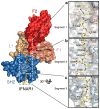Structural basis of recognition of interferon-α receptor by tyrosine kinase 2
- PMID: 24704786
- PMCID: PMC4161281
- DOI: 10.1038/nsmb.2807
Structural basis of recognition of interferon-α receptor by tyrosine kinase 2
Abstract
Tyrosine kinase 2 (TYK2) is a member of the Janus kinase (JAK) family of nonreceptor tyrosine kinases, which are essential for proper signaling in immune responses and development. Here we present a 2.0-Å-resolution crystal structure of a receptor-binding fragment of human TYK2, encompassing the FERM and SH2 domains, in complex with a so-called 'box2'-containing intracellular peptide motif from the interferon-α receptor chain 1 (IFNAR1). The TYK2-IFNAR1 interface reveals an unexpected receptor-binding mode that mimics a SH2 domain-phosphopeptide interaction, with a glutamate replacing the canonical phosphotyrosine residue. This structure provides the first view, to our knowledge, of a JAK in complex with its cognate receptor and defines the molecular logic through which JAKs have evolved to interact with divergent receptor sequences.
Conflict of interest statement
Figures





Comment in
-
JAK-cytokine receptor recognition, unboxed.Nat Struct Mol Biol. 2014 May;21(5):431-3. doi: 10.1038/nsmb.2824. Nat Struct Mol Biol. 2014. PMID: 24799036 No abstract available.
References
-
- Leonard WJ, O’Shea JJ. Jaks and STATs: biological implications. Annu Rev Immunol. 1998;16:293–322. - PubMed
-
- Haan C, Kreis S, Margue C, Behrmann I. Jaks and cytokine receptors--an intimate relationship. Biochem Pharmacol. 2006;72:1538–1546. - PubMed
-
- Radtke S, et al. The Jak1 SH2 domain does not fulfill a classical SH2 function in Jak/STAT signaling but plays a structural role for receptor interaction and up-regulation of receptor surface expression. J Biol Chem. 2005;280:25760–25768. - PubMed
Publication types
MeSH terms
Substances
Associated data
- Actions
Grants and funding
LinkOut - more resources
Full Text Sources
Other Literature Sources
Molecular Biology Databases

